

How to Write a Long Essay

How to Write a One Page Essay
Writing an essay as part of a school assignment or a project can be a very tedious task, especially if that essay needs to be long. Even the most confident writers may have no trouble writing a few pages for an assignment but may find it challenging to extend that word count as much as possible. If you're assigned a long essay for one of your classes, there's no reason to worry. With some useful tips at your disposal, you can stretch that essay out without making it sound repetitive or boring the reader with an influx of irrelevant information.
What Is a Long Essay?
A long essay is any essay that tends to be longer than three pages or 3,000 words or more. Of course, the definition of a long essay will differ from one classroom to another, depending on the age and level of the students. And even if you're a college student, you may have some professors who consider a five-page essay to be the average, while another teacher considers five pages to be too much. Therefore, it's important to check with your teacher, though they'll usually clarify this when giving the assignment.
Sometimes, the term "long" applies to how many pages, and sometimes it applies to how many paragraphs or words need to be in the essay. Again, this all depends on your teacher, your school's requirements and the nature of the assignment. Either way, hearing your teacher say that you must write a long essay for your next assignment can certainly cause a lot of stress. The good news is that writing a long essay can be much easier than writing a short essay, especially if you're given some meaningful advice.
Why Would You Be Required to Write a Long Essay?
There are many reasons why teachers would assign a long essay to their students. First of all, writing a long essay is an opportunity for a student to really put his or her writing skills to the test. By the time students get to college, they already have an idea as to how to write a decent paper, but perhaps it's within limits. College professors need to make sure that students are able to write well, because eventually, these students may need to write a thesis or dissertation, and there really is no longer essay than that.
So even though you may think of writing a long essay as a torturous assignment, it's actually a great opportunity to practice a very specific skill that will definitely come in handy in other areas of your life. And, if you build up the right mindset for yourself, writing that long essay shouldn't be any more difficult than any other assignment you've been required to complete.
What Is the Standard Essay Format?
There's a standard essay format understood by most English students around the world. This is how essay writing can be taught in a universal way so that students are successful at writing essays no matter where they're studying. A standard essay format typically includes an introduction, three body paragraphs and a conclusion. Of course, the older a student gets and the more experience they have in school, their essays will gradually get longer and will need to require more detail and features (for instance, citing sources) in order to meet the requirements set by the teacher.
When you need to write a long essay, you can and should still base your writing off of this standard essay format. The only difference is that instead of having three body paragraphs, you're going to have a lot more in order to reach the word count or page requirement that you need to meet. This isn't as hard as it sounds. Instead of squeezing your main idea into one paragraph, try to add more examples and details to make it longer. Also, try to think of other key points that support your essay's theme that might not be so obvious at first.
Start Ahead of Time
The best way to relieve the stress that comes with having to write a long essay is to start ahead of time. Too many college students (and high school students) wait until the last possible minute to write an essay. Though some students may certainly be able to get away with this, it'll be a lot harder when it comes to writing a longer essay. Therefore, make sure you give yourself plenty of time to complete the assignment. It may work better for some people to do a little bit each day until they reach their goal. For instance, if you're required to write 3,000 words for your long essay, then you may feel better writing just 500 words a day over a couple of days instead of trying to bang it all out at once.
How to Write a 3,000 Word Essay in a Day
Some students rather get the hard work out of the way, instead of letting it drag out over a week. Writing a long essay of 3,000 words can be done in a day if you just put your mind to it. Do the following:
- Don't schedule any other appointments or assignments for the day.
- Put away any potential distractions, like your phone or the TV.
- Stay off of social media.
- Work somewhere quiet, like the library or a calm cafe.
- Take breaks every few paragraphs.
- Set a timer for ten minutes and try to work the entire time without stopping.
Create Your Essay Structure
Once you've decided whether or not you're going to write the essay over a couple of days or in just one day, it's time to start writing the actual essay. Like with any writing assignment, the first thing you should do is create an outline and organize your overall essay structure. If you need to write around five pages, which makes sense for a long essay, then you should make an outline that will support that. Take a look at an essay format example to get an idea of how yours should be:
- Introduction (more than two paragraphs)
- A starter question (something for the reader to consider)
- Body "paragraph/idea" one (four paragraphs on average)
- Body "paragraph/idea" two (four paragraphs on average]
- Body "paragraph/idea" three (four paragraphs on average)
- A conclusion
If you're wondering how on earth you're going to create a body section that's four paragraphs long, try to think of one main idea and three examples that tie together with it. For instance, if your long essay is an argumentative piece about "The Importance of Waiting Until You're Financially Stable to Have Children" you can think of at least four key reasons why:
- You won't have to struggle to pay for their needs.
- You can give them more opportunities.
- You can travel as a family.
- You can put away money for their college tuition.
For the first idea, you can talk about this point in very general terms. Then, you can write three more paragraphs underneath that, with each paragraph discussing a specific example. The second paragraph, for example, can be about paying for things like diapers, clothes, formula, etc., and how much each item costs. The second example can be about paying for things when the child gets a little older, like their food, their school supplies, etc. Lastly, the third example (and the fourth paragraph in this section) can discuss paying for things that the child will need as a teenager, such as more clothes, sports uniforms, dental work, etc.
Did You Answer All the Questions?
After you feel like you've exhausted all examples, but you're still under word count or page count, go back and make sure you've answered all the questions. These questions may have been questions in the rubric or the writing prompt that your teacher provided, or they may be questions that you've thought of on your own. In fact, when you start thinking of what to write about, you should brainstorm some questions that a reader may want to find the answer to about the topic, and you should try to answer these throughout your essay. Creating more potential questions can help you reach your word count faster.
Can You Change Words?
If you're close to reaching your word count but you're still not quite there, then go back and see if you can change any of the language in your essay to make it longer. For example, if you have a lot of contractions in your paper (can't, won't, isn't, they're) go back and make them two words instead of contractions, and do this throughout the entire essay. This is a great solution because it won't take away from the readership of your essay, and while this won't extend the word count too much, it will definitely help a bit.
Think of Additional Details You Can Add
In addition to changing contractions, you can also think of other details you can add to elongate your essay. There are always more examples you can add or more information you can research that will not only resonate with the reader but increase your overall word count or page count.
For example, if you're talking about how parents who decide to have children once they're financially stable will have the opportunity to put more money toward their child's tuition, then you can go back and add plenty of detail supporting this argument. Did you give an example of how much tuition costs? Did you add details about what parents can do with the money if their children decide not to go to college? What about the different types of college funds that exist? These are all details you can add that will increase the length of your essay, while also adding value.
However, when you do this, keep in mind that you want to be very careful not to add too much "fluff." Fluff is when you add information or details that simply aren't valuable to the writing itself. It makes the reader (who in most cases is your teacher and the one grading the assignment) want to skim over your piece, and this can lead to him or her giving you a lower grade.
Edit, Edit, Edit
Last but not least, in order to write a long essay, you must have the capacity to edit your work. Editing not only helps to ensure your paper is long enough, reads well, and is free from grammatical errors, but it will also give you an opportunity to add in more information here and there. To edit, you should always read out loud to yourself, and take a break from your work, so you can revisit it with a fresh pair of eyes. You can easily check if you've reached the length requirements by clicking on "word count" or counting the number of pages yourself, though your document will reveal this as you scroll down.
Related Articles

How to Write an Advantages and Disadvantages Essay

How to Make an Essay Longer

How to Write an Essay Fast

Problems That Students Encounter With Essay Writing

How to Write a 3,000 Word Essay

Personal Statement for scholarship: How to Write One, How long Does ...

College Essay Ideas

10 Good Transitions for a Conclusion Paragraph
- Save the Student: How to Write a 3,000 Word Essay in a Day
- International Student: General Essay Writing Tips
- You may want to have a friend read through your essay. He may catch mistakes that you have missed.
Hana LaRock is a freelance content writer from New York, currently living in Mexico. Before becoming a writer, Hana worked as a teacher for several years in the U.S. and around the world. She has her teaching certification in Elementary Education and Special Education, as well as a TESOL certification. Please visit her website, www.hanalarockwriting.com, to learn more.
Home / Guides / Writing Guides / Writing Tips / How to Make an Essay Longer the Smart Way
How to Make an Essay Longer the Smart Way
Meeting an essay’s required page or word count can sometimes be a struggle, especially if you’re juggling multiple papers or exams. In a pinch, students often rely on tricks like increasing margin size or making their font slightly bigger. Though these tricks do increase page length, there are easier (and smarter) ways to write a longer, high-quality essay. Making a paper meet minimum word or page counts doesn’t have to be an agonizing process—you can add length while also adding clarity and depth.
Here are 10 tips on how you can write a longer and a smarter essay, even if the deadline is fast approaching:
Tip #1: Look Back at Your Prompt/Rubric/etc.
If you’ve been provided a comprehensive prompt or rubric for an essay, read it, and read it again. Think about the following:
- Did you answer all of the questions in the prompt?
- Did you provide supporting evidence to back up whatever claims you made?
- Did you leave out any information that might increase the reader’s understanding of your argument?
- Did you meet all requirements (besides length) for the paper?
If the answer isn’t a decisive “yes” to every question on this list, go back and revise.
Tip #2: Go Back Through Your Introduction and Conclusion
Often times, ideas evolve while writing a paper. If the first thing you wrote was the introduction, go back and reread the first paragraph. You might decide that you left out key information that aids the reader in understanding your argument. When looking back on the conclusion, make sure you’ve both summarized the main points within the essay and provided your reader with a solution to consider. If you don’t feel you’ve done this, go back through and revise the paper.
Tip #3: Have Someone Proofread Your Essay
Even if you’re short on time ask a friend, sibling, or parent to read through your paper, specifically noting any points they find confusing. Then, go back and revise the parts that were unclear, adding in more information to provide readers with further clarity. You have a more comprehensive understanding of what you’re writing about than your reader, so having someone else look over your paper can be a helpful way to ensure that you haven’t missed any important details.
Tip #4: Use Quotations
Chances are, you have already used quotes in your paper. Quotations are a great way to enhance your argument while also driving up a paper’s word count, but don’t add quotes just for the sake of doing so. If you’re short on words, read through your source materials again to see if you’ve missed any valuable quotes. You can also do a little more research to see if there are any other sources you can add to provide the reader with more evidence toward your argument. Longer quotes aren’t necessarily better, but if you’re really in a bind, you might want to lengthen some of the quotes that are already included.
Tip #5: Review Your Outline
Did you make an outline to plan the essay when you first started? Go back through that initial outline and make sure you’ve hit all of your intended points. It’s possible that you’ve left out an important piece of your argument that would both increase page count and make for a better essay.
Tip #6: Include More Transitional Phrases
Graders often look for traditional words linking sentences to each other, like “therefore,” “even though”, and “on the other hand.” Read through your essay and make sure the sentences flow smoothly into each other. If they don’t, go back and add in transitional phrases like the ones listed above. Your writing will be easier to read, and you’ll get closer to the minimum page requirement in the process.
Tip #7: Read Your Paper Out Loud
This might sound like a silly tip, but when you read your paper out loud, you become increasingly aware of any grammatical or syntactical issues. When you rephrase sentences to fix these, you might end up increasing the paper length a bit. In the process of reading out loud, you also might realize that you didn’t include sufficient details within a particular paragraph. If that’s the case, go back in and add more to increase length.
Tip #8: Take a Break From Your Essay
You’ve probably been staring at your computer screen for hours, hoping words will magically pop into your head. Take a break. Eat a snack, go for a walk, or talk to a friend on the phone. You’ll come back to the essay with a fresh perspective after some time away, and you might have new ideas after you’ve had time away from your paper.
Tip #9: Ask Your Instructor for Help
Most teachers, teaching assistants, and professors are willing to look over papers for students before the final submission date. If there is still time, ask if you can make an appointment to go over your paper or head over to office hours. Your instructor might offer tips on how to better answer the prompt, and this in turn may also increase the word count of the paper.
Tip #10: Use multiple examples to back up your argument
If you’ve only used one source or anecdote to explain a given point, find a second source to provide additional evidence for the reader. This method will help drive up a paper’s word count while also providing further support for your argument.
Although hitting a minimum page count can sometimes be challenging, you can do it the smart way by increasing the information you provide to the reader—there’s no reason to resort to tricks like increasing line spacing or font size. If you’re really in a bind at the last minute, you might want to break up some of your paragraphs. This increases length while also making text more manageable for a reader. But after going through the tips on this list, your paper should be adequate in length without you having to even consider spacing.
EasyBib Writing Resources
Writing a paper.
- Academic Essay
- Argumentative Essay
- College Admissions Essay
- Expository Essay
- Persuasive Essay
- Research Paper
- Thesis Statement
- Writing a Conclusion
- Writing an Introduction
- Writing an Outline
- Writing a Summary
EasyBib Plus Features
- Citation Generator
- Essay Checker
- Expert Check Proofreader
- Grammar Checker
- Paraphrasing Tools
Plagiarism Checker
- Spell Checker
How useful was this post?
Click on a star to rate it!
We are sorry that this post was not useful for you!
Let us improve this post!
Tell us how we can improve this post?
Grammar and Plagiarism Checkers
Grammar Basics
Plagiarism Basics
Writing Basics
Upload a paper to check for plagiarism against billions of sources and get advanced writing suggestions for clarity and style.
Get Started
Ultimate Guide to Writing Your College Essay
Tips for writing an effective college essay.
College admissions essays are an important part of your college application and gives you the chance to show colleges and universities your character and experiences. This guide will give you tips to write an effective college essay.
Want free help with your college essay?
UPchieve connects you with knowledgeable and friendly college advisors—online, 24/7, and completely free. Get 1:1 help brainstorming topics, outlining your essay, revising a draft, or editing grammar.
Writing a strong college admissions essay
Learn about the elements of a solid admissions essay.
Avoiding common admissions essay mistakes
Learn some of the most common mistakes made on college essays
Brainstorming tips for your college essay
Stuck on what to write your college essay about? Here are some exercises to help you get started.
How formal should the tone of your college essay be?
Learn how formal your college essay should be and get tips on how to bring out your natural voice.
Taking your college essay to the next level
Hear an admissions expert discuss the appropriate level of depth necessary in your college essay.
Student Stories
Student Story: Admissions essay about a formative experience
Get the perspective of a current college student on how he approached the admissions essay.
Student Story: Admissions essay about personal identity
Get the perspective of a current college student on how she approached the admissions essay.
Student Story: Admissions essay about community impact
Student story: admissions essay about a past mistake, how to write a college application essay, tips for writing an effective application essay, sample college essay 1 with feedback, sample college essay 2 with feedback.
This content is licensed by Khan Academy and is available for free at www.khanacademy.org.
How to Write the Perfect Essay
06 Feb, 2024 | Blog Articles , English Language Articles , Get the Edge , Humanities Articles , Writing Articles

You can keep adding to this plan, crossing bits out and linking the different bubbles when you spot connections between them. Even though you won’t have time to make a detailed plan under exam conditions, it can be helpful to draft a brief one, including a few key words, so that you don’t panic and go off topic when writing your essay.
If you don’t like the mind map format, there are plenty of others to choose from: you could make a table, a flowchart, or simply a list of bullet points.
Discover More
Thanks for signing up, step 2: have a clear structure.
Think about this while you’re planning: your essay is like an argument or a speech. It needs to have a logical structure, with all your points coming together to answer the question.
Start with the basics! It’s best to choose a few major points which will become your main paragraphs. Three main paragraphs is a good number for an exam essay, since you’ll be under time pressure.
If you agree with the question overall, it can be helpful to organise your points in the following pattern:
- YES (agreement with the question)
- AND (another YES point)
- BUT (disagreement or complication)
If you disagree with the question overall, try:
- AND (another BUT point)
For example, you could structure the Of Mice and Men sample question, “To what extent is Curley’s wife portrayed as a victim in Of Mice and Men ?”, as follows:
- YES (descriptions of her appearance)
- AND (other people’s attitudes towards her)
- BUT (her position as the only woman on the ranch gives her power as she uses her femininity to her advantage)
If you wanted to write a longer essay, you could include additional paragraphs under the YES/AND categories, perhaps discussing the ways in which Curley’s wife reveals her vulnerability and insecurities, and shares her dreams with the other characters. Alternatively, you could also lengthen your essay by including another BUT paragraph about her cruel and manipulative streak.
Of course, this is not necessarily the only right way to answer this essay question – as long as you back up your points with evidence from the text, you can take any standpoint that makes sense.

Step 3: Back up your points with well-analysed quotations
You wouldn’t write a scientific report without including evidence to support your findings, so why should it be any different with an essay? Even though you aren’t strictly required to substantiate every single point you make with a quotation, there’s no harm in trying.
A close reading of your quotations can enrich your appreciation of the question and will be sure to impress examiners. When selecting the best quotations to use in your essay, keep an eye out for specific literary techniques. For example, you could highlight Curley’s wife’s use of a rhetorical question when she says, a”n’ what am I doin’? Standin’ here talking to a bunch of bindle stiffs.” This might look like:
The rhetorical question “an’ what am I doin’?” signifies that Curley’s wife is very insecure; she seems to be questioning her own life choices. Moreover, she does not expect anyone to respond to her question, highlighting her loneliness and isolation on the ranch.
Other literary techniques to look out for include:
- Tricolon – a group of three words or phrases placed close together for emphasis
- Tautology – using different words that mean the same thing: e.g. “frightening” and “terrifying”
- Parallelism – ABAB structure, often signifying movement from one concept to another
- Chiasmus – ABBA structure, drawing attention to a phrase
- Polysyndeton – many conjunctions in a sentence
- Asyndeton – lack of conjunctions, which can speed up the pace of a sentence
- Polyptoton – using the same word in different forms for emphasis: e.g. “done” and “doing”
- Alliteration – repetition of the same sound, including assonance (similar vowel sounds), plosive alliteration (“b”, “d” and “p” sounds) and sibilance (“s” sounds)
- Anaphora – repetition of words, often used to emphasise a particular point
Don’t worry if you can’t locate all of these literary devices in the work you’re analysing. You can also discuss more obvious techniques, like metaphor, simile and onomatopoeia. It’s not a problem if you can’t remember all the long names; it’s far more important to be able to confidently explain the effects of each technique and highlight its relevance to the question.

Step 4: Be creative and original throughout
Anyone can write an essay using the tips above, but the thing that really makes it “perfect” is your own unique take on the topic. If you’ve noticed something intriguing or unusual in your reading, point it out – if you find it interesting, chances are the examiner will too!
Creative writing and essay writing are more closely linked than you might imagine. Keep the idea that you’re writing a speech or argument in mind, and you’re guaranteed to grab your reader’s attention.
It’s important to set out your line of argument in your introduction, introducing your main points and the general direction your essay will take, but don’t forget to keep something back for the conclusion, too. Yes, you need to summarise your main points, but if you’re just repeating the things you said in your introduction, the body of the essay is rendered pointless.
Think of your conclusion as the climax of your speech, the bit everything else has been leading up to, rather than the boring plenary at the end of the interesting stuff.
To return to Of Mice and Men once more, here’s an example of the ideal difference between an introduction and a conclusion:
Introduction
In John Steinbeck’s Of Mice and Men , Curley’s wife is portrayed as an ambiguous character. She could be viewed either as a cruel, seductive temptress or a lonely woman who is a victim of her society’s attitudes. Though she does seem to wield a form of sexual power, it is clear that Curley’s wife is largely a victim. This interpretation is supported by Steinbeck’s description of her appearance, other people’s attitudes, her dreams, and her evident loneliness and insecurity.
Overall, it is clear that Curley’s wife is a victim and is portrayed as such throughout the novel in the descriptions of her appearance, her dreams, other people’s judgemental attitudes, and her loneliness and insecurities. However, a character who was a victim and nothing else would be one-dimensional and Curley’s wife is not. Although she suffers in many ways, she is shown to assert herself through the manipulation of her femininity – a small rebellion against the victimisation she experiences.
Both refer back consistently to the question and summarise the essay’s main points. However, the conclusion adds something new which has been established in the main body of the essay and complicates the simple summary which is found in the introduction.

Hannah is an undergraduate English student at Somerville College, University of Oxford, and has a particular interest in postcolonial literature and the Gothic. She thinks literature is a crucial way of developing empathy and learning about the wider world. When she isn’t writing about 17th-century court masques, she enjoys acting, travelling and creative writing.
Recommended articles

A Day in the Life of an Oxford Scholastica Student: The First Monday
Hello, I’m Abaigeal or Abby for short, and I attended Oxford Scholastica’s residential summer school as a Discover Business student. During the Business course, I studied various topics across the large spectrum that is the world of business, including supply and...

Mastering Writing Competitions: Insider Tips from a Two-Time Winner
I’m Costas, a third-year History and Spanish student at the University of Oxford. During my time in secondary school and sixth form, I participated in various writing competitions, and I was able to win two of them (the national ISMLA Original Writing Competition and...

Beyond the Bar: 15 Must-Read Books for Future Lawyers
Reading within and around your subject, widely and in depth, is one of the most important things you can do to prepare yourself for a future in Law. So, we’ve put together a list of essential books to include on your reading list as a prospective or current Law...

The Secret(s) to Getting Through Long Papers

By Sophie, a Writing Center Coach
It’s the beginning of the semester—meaning, as a graduate student, it’s time for me to get back into the groove of planning and writing long papers. For me, the hardest part of approaching a paper is coming up with a topic that will stay interesting to me throughout the research and writing process. A good example of this is from the end of last semester, when I found myself dreading the final paper for my archives class. We covered so many interesting topics in the class, it was hard to decide which one to choose.
In my experience, a bad topic can make the writing process feel infinitely longer and more stressful. As I thought about my archives paper, I worried about finding something that I could focus on for 12 pages. So many of the topics in my class felt interwoven, and I was afraid it would be hard to pick out one thread. If I try to start a long paper without planning, I’ll end up staring at the same sentence or paragraph for hours, trying to figure out what I could possibly say next.
So, when I finally had to commit to a topic, I decided to break down the process into a few fun steps. Dividing it up helped take away some of my worries and made the process easier because I only had to do one step at a time. Here’s how I got started:
1) Create a real brainstorming session
First, I decided to meet up with a few of my friends who were also in the class. We went to a coffee shop we all like, and we brought our notes and readings from the class. None of us had a concrete idea about what to write; we just wanted to throw some possibilities out to see how other people would react to them.
We started by talking about some of the things we found funny or interesting in previous class discussions. As we talked, we found natural points of disagreement and interest. I took notes about points that stuck out to me. At the end of the conversation, I had a document full of questions and arguments that I wanted to explore further.
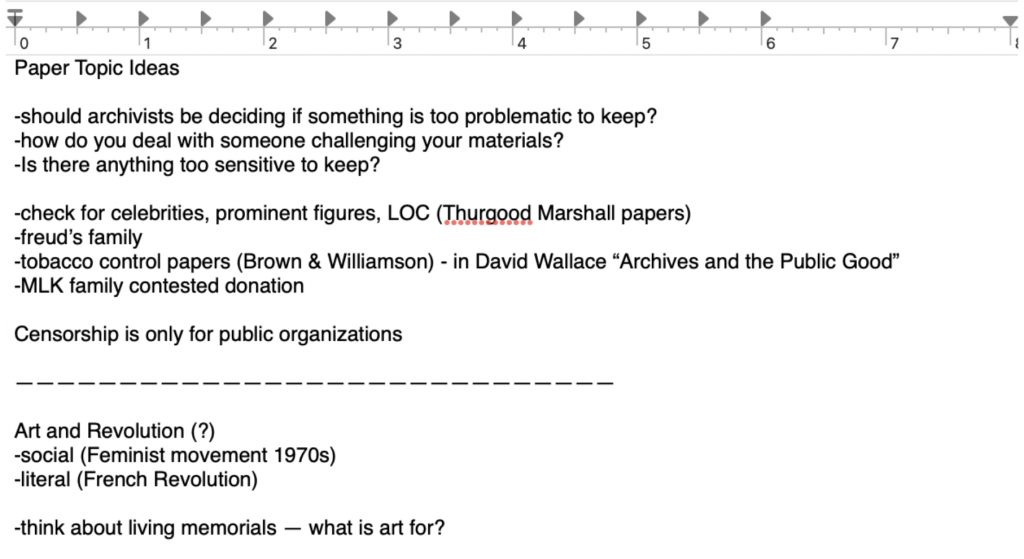
My friends also thought of topics, but they arrived at their ideas in different ways. One of my friends kept coming back to a short paper she had already written, and by talking about it, she discovered that she had much more to say. Another friend talked about something that he felt was conspicuously missing from our class discussions, so he decided that this paper would be a good opportunity to learn more.
All three of us came out of the session with inspiration and initial feedback. This step reminded me of the value of talking through my ideas, especially since my peers could push me to think more deeply about particular questions. Plus, connecting with my classmates through discussion helped me get excited about writing.
Alternatively, I know that, for some people, meeting with friends isn’t always effective; there are also other ways to brainstorm. Sometimes, it helps to talk to someone who doesn’t know about the class or topic—like a Writing Center coach ! For others, the note-taking part could be like having a conversation with yourself, which might be all you need. The Writing and Learning Centers also have some great tools for brainstorming if you prefer to work independently.
2) Conduct some initial research
Once I had the beginnings of an idea, I decided to look for sources that could help me narrow my topic. The first place I go to find scholarly articles is the UNC Libraries’ page with “Resource Tools.” At this phase, I like to do keyword searches with Articles+. When you open the advanced search options, you can limit your results to be really specific by choosing a discipline, language, date the material was published, and whether the source needs to be scholarly/peer reviewed. In this case, I used “AND” to limit my results to articles with all of my desired keywords, like: “Sexual material” AND “Archives.” There’s another great article that explains the logic behind this kind of search, which uses Boolean logic.
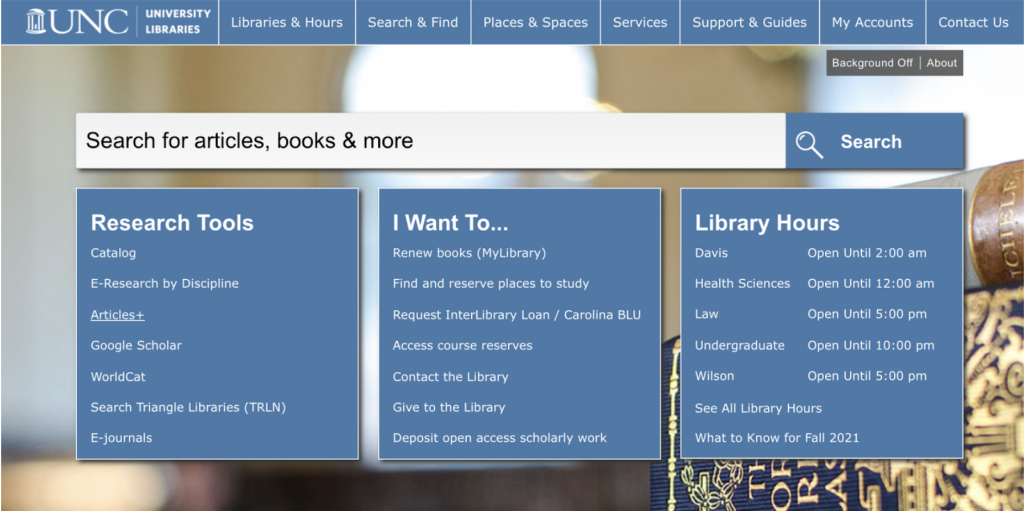
After I’ve combed through relevant results for one search, I’ll usually adjust my keywords to see if anything new pops up. I’ll also see if the best articles (the ones that feel most related to my topic) have been cited by anyone else and whether those articles have something to offer me. I also repeat this process with Google Scholar and with the “E-research by Discipline” option, which will lead me to specific databases for my field.
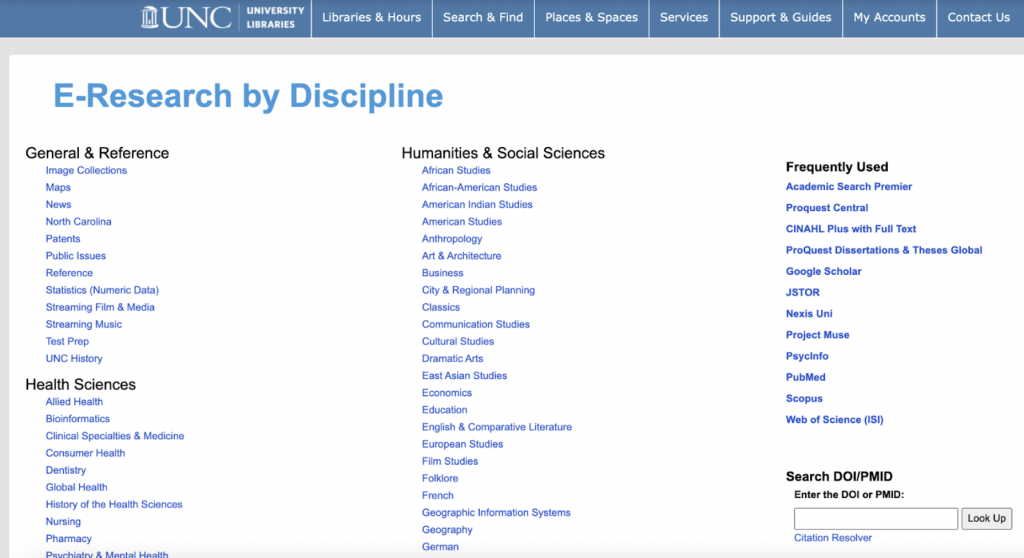
In this case, I used the Information and Library Science option, which took me to the best databases for journals in my discipline. Searching within a discipline allows me to think more carefully about my keywords; I might not have to include “archives,” or “libraries,” for example, because many of the articles are already about archives.
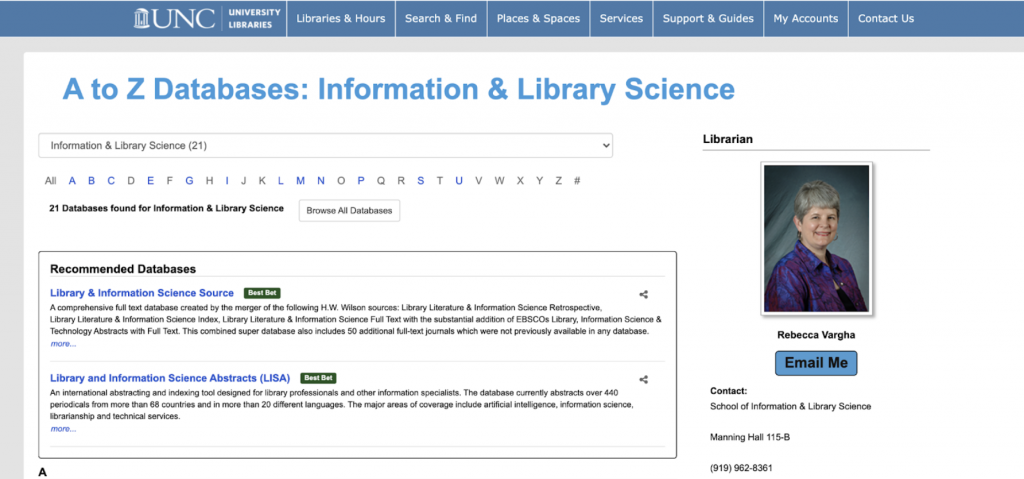
As I’m going along, I like to save any articles that I find in Zotero, a citation manager that I downloaded from the library’s website. Within Zotero, I make a folder for the assignment (“Final Paper”), and it automatically saves all the information I need to quickly go back to the article if I need it. (Note: I first learned about using Zotero from a helpful university librarian, so if you’re new to citation managers, it might be helpful to have a librarian give you a tutorial. You can also read another blog article on using Zotero .)
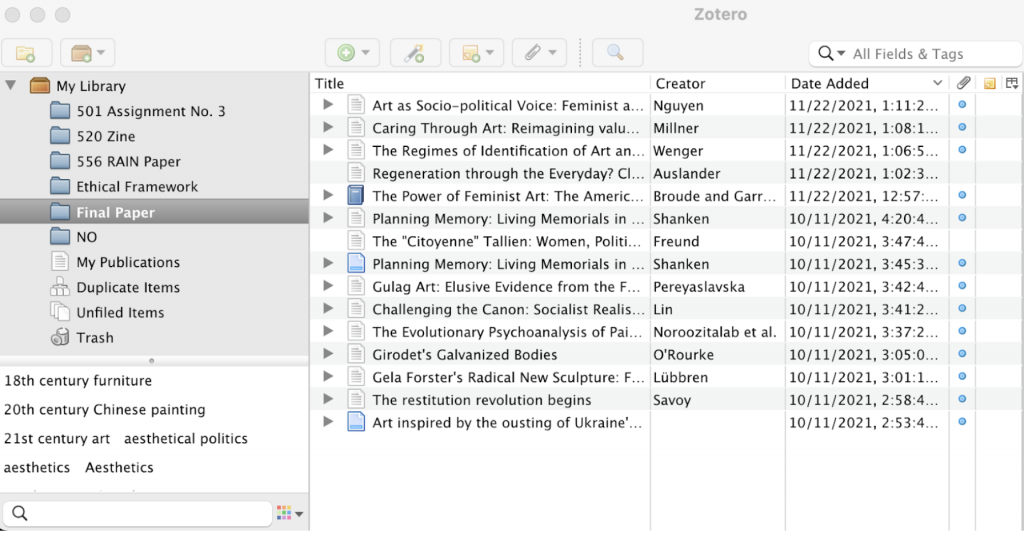
At the end of this process, I usually have a file full of “maybe” sources that I could come back to later. This helps give me an idea of what people have already said about this topic and where I might be able to add to the conversation.
3) Meet with your professor
After I came up with an idea and did some preliminary research, I thought it would be a good idea to check in with my professor during office hours. Since my professor is an expert in the field, I knew she would have a better sense of the context surrounding my research question.
(Note: Sometimes I like to go to office hours before I do any research; getting some expertise at the beginning can make the search process even faster. In this case, my professor encouraged us to find what we could before checking in with her.)
Before the meeting, I read through the abstracts of the sources I had already found in my preliminary research (those were saved in my Zotero library). Based on those, I wrote down some questions that I had about the topic. I met with my professor for about 15 minutes, and in that time, I pitched my question and told her what I had already found. She was able to direct me to some additional books and cases to look at, and I wrote those down to research later.
My professor also encouraged me to post my topic in our class’ Sakai forum. She created a discussion page specifically for final topic ideas so that my other classmates could provide feedback. Often, she said, students with similar topics will find sources that are helpful to each other, so the forum is a good place to share resources. I left the meeting with a strong sense of direction of what I needed to begin the actual writing.
After going through these steps, I felt like I had a good idea of what I wanted to write about and some evidence that could support my argument. Still, because it was such a long paper, I felt like I needed help to get started on the outline and the actual writing process. So, I decided to make a Writing Center Appointment to get my ideas in order and to make a plan for finishing the paper on time. Again, since I’m a person who likes to talk through my ideas, it was helpful to hear another person’s reaction to my topic so far. It also gave me a self-imposed deadline to complete these initial steps.
Breaking down the first few steps of writing my research paper helped me think of it as a list of small tasks to check off instead of one giant, frustrating project. It felt good to accomplish little things that I knew would add up to finishing the whole thing. This process also led me to a topic that really excited and engaged me, so when it was time to do the final step (the actual writing), I was happy to get started.
This blog showcases the perspectives of UNC Chapel Hill community members learning and writing online. If you want to talk to a Writing and Learning Center coach about implementing strategies described in the blog, make an appointment with a writing coach , a peer tutor , or an academic coach today. Have an idea for a blog post about how you are learning and writing remotely? Contact us here .
- Have your assignments done by seasoned writers. 24/7
- Contact us:
- +1 (213) 221-0069
- [email protected]

How to Write a Long Essay, Term Paper or Research Paper
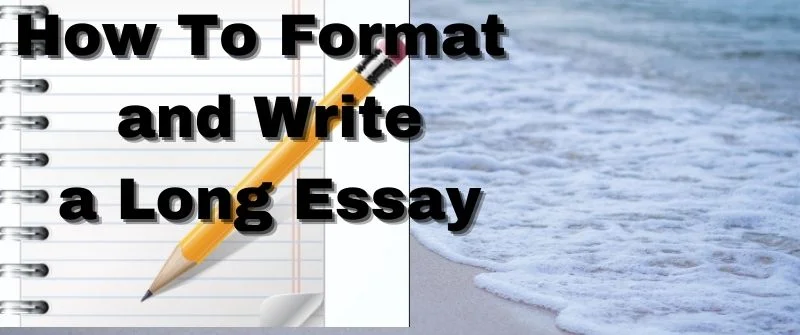
How To Format a Long Essay
A long essay is an essay longer than 3 pages. This varies with the level of education. Some college instructors will view a five-page essay as short and others as average.
The phrase ‘long essay’ can be used to refer to the number of words, the number of pages, and sometimes the number of paragraphs. Most instructors usually clarify how long essays should be before issuing them.

What Is A Long Essay In Research?
A long essay in research is a ten-page or more essay that analyses, interprets, and compares researched ideas to the ideas of the writer.
Research papers are usually longer than academic essays. They are usually more detailed and test writing and scholarly research skills.
People Also Read: Essay Writing Topics with Answers:21 Examples in English
How to Write Long Essays
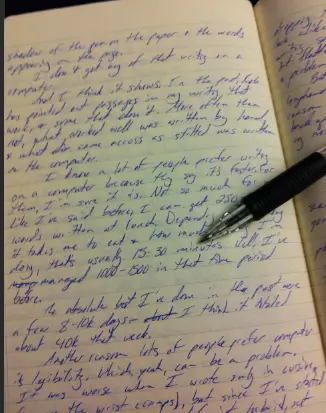
Most students complain that it is overwhelming to write long essays. The stress that comes with writing long essays contributes to many students wanting to put them off. Tackling long essays can become easy by following the following steps:
1. Pick a Topic
When granted the freedom to choose a topic, pick a broad and specific one. It is easy to find and write about a broad topic.
Topics with scarce research material generate little content and are not suitable for long essays.
One may likely end up getting stranded halfway into the essay with nothing more to write about on a topic. For example, the effects of Racism in America in the 2000s is a broader topic than the effects of racism in America in 2004.
2. Start your Research
Researching on a long essay can take hours and days. Thorough research is important in the formulation of a thesis. It makes it easy to determine the sources that are more important and valuable to your topic. The more sources you get the better and longer your essay will be.
3. Write a Thesis
The thesis statement is crucial because its shapes your entire essay. The thesis statement you formulate should be specific.
It should outline the main argument that you will try making in the essay. Use the thesis to explain why the question you want to answer is important.
In long essays, thesis statements should appear at the end of the first paragraph or on the second paragraph.
4. Finish your Research
With the thesis statement already established, continue doing research. The research should focus on the points that support the thesis statement you have come up with.
Any point that does not align with the thesis statement is not meant for your essay. All the sources you use for research should help develop your thesis statement. The sources should be credible and authentic to strongly support the thesis.
5. Make an Outline
An outline helps you organize thoughts and plan how you will write your essay. Without outlines, you are likely to get lost in the middle of your essay.
With an outline, writing is easy and fast with an organized flow of ideas. The more detailed your outline is the more ease you will have when writing the essay.
6. Write the Essay
Start writing your essay. Keep your head down and avoid distraction. Read through your writing to make sure that your ideas flow and paragraphs connect.
7. Proofread and Edit
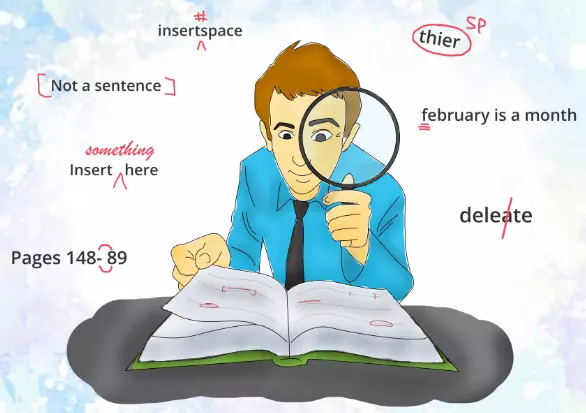
You should read your paper out loud when proofreading.
This helps you notice any grammatical, punctuation, or paraphrasing errors in your essay.
You can choose to edit the errors as you read or write them down and correct them once you are done proofreading.
People Also Read: Essay Writing Titles: Being Creative Without Topic Generators
How to Balance your Points in a Long Essay
Formulate a thesis.

To balance your points in an essay you first need a thesis statement. A thesis statement will set the tone of how your points will be balanced.
With the thesis, you will be able to understand your essay better. This in turn helps you balance your points.
Write the introduction paragraph
Introduce your essay in the best way possible. Make it clear what you will talk about in your essay. Do not use fancy language that the reader will find hard to understand. At the end of the introduction paragraph write the thesis statement.
Supportive paragraphs
These are paragraphs that make up the body of your essay. They explain all points in your essay. Each point should be represented in its paragraph.
The first sentence of each paragraph is the topic sentence that states the point you will talk about. Explain the points exhaustively as the paragraph progresses.
People Also Read: Linking Words for Essay Writing: Useful Paragraph Phrases
The conclusion summarizes everything you have talked about in the essay. If readers happen to read the conclusion only they should grasp everything about your essay.
If writing a conclusion is hard, you can use your thesis statement as the conclusion because it also presents what your essay is all about.
Tips on How to Format a Long Essay
Instructors give long essays to their students to test their writing skills. An example of such a long task is writing a 4000-word essay that can take someone quite some time. The standard essay format is introduction, body, and conclusion.
The format for long essays includes two introduction paragraphs, 3 ideas in the body with each idea presented in four paragraphs, and a conclusion. This gives the writer the chance to achieve the given length.
People Also Read: Is Using an Essay Writing Service Cheating: It’s Legal
How to Make an Essay Long the Smart Way

Essays can be made long in the following way:
1. Expanding descriptions
Descriptions are very important, especially in descriptive essays.
Even if you have defined them you can add more information to make them more detailed.
2. Enhancing transitions
Transitions not only enable the reader to smoothly navigate through your points but also add length to your essay.
Additionally, great transitions make your essay better and are signs of a great writer.
This is different for short essays. Read more on how to write short essays to know why long transitions may not be included.
3. Expanding paragraphs
Go through your essay and find points that are not explained clearly and explain them clearly.
You can’t know everything about a topic. There will be always relevant information to add to the points of your essay. You can explain the basics if you did not do so and define important terms as well.
4. Adding the Introduction
No rule states that introductions should be short. They should be detailed because they tell the reader what to expect and set the tone for your essay. If you rushed over the introduction revise it and add more ideas to make it detailed and catchier.
5. Make sure that you have Included Everything
Revisit your outline and check whether you have included all the points you wanted to in the essay. If not, add them. Sometimes you may rush when writing the essay and forget to include all the points you intended to.
6. Checking the Assignment Again
Reading the assignment again can help you think of new ideas to include in your essay. This is because you may not have exhausted everything on the topic and reading the assignment again can open up your mind to a new thinking dimension. Also, you may have missed something in the instructions that you should add to the essay.
7. Add Quotations
Quotations help show the reader that you understand what you are writing about. You can bring in two quotes from famous writers to support your arguments. Always remember to cite and reference them to avoid plagiarism.

8. Asking a Friend what is Missing
After doing all of the above and still not achieving the length you want, ask a friend to read your essay. They will help you identify what is missing and unclear in your work. It is not easy receiving constructive criticism in your work but that is one way to make it better.

When not handling complex essays and academic writing tasks, Josh is busy advising students on how to pass assignments. In spare time, he loves playing football or walking with his dog around the park.
Related posts
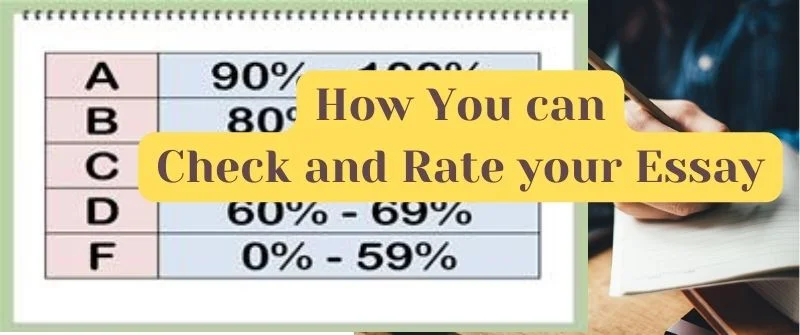
Check My Essay Grade
Check My Essay Grade: How To Rate Your Essay
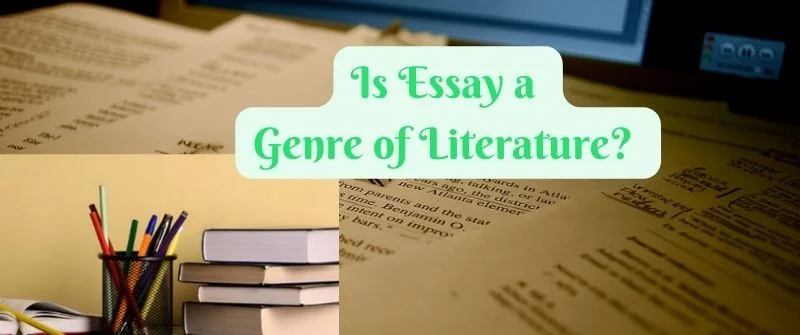
Is Essay a Genre
Is Essay a Genre of Literature: Its Structure and Examples
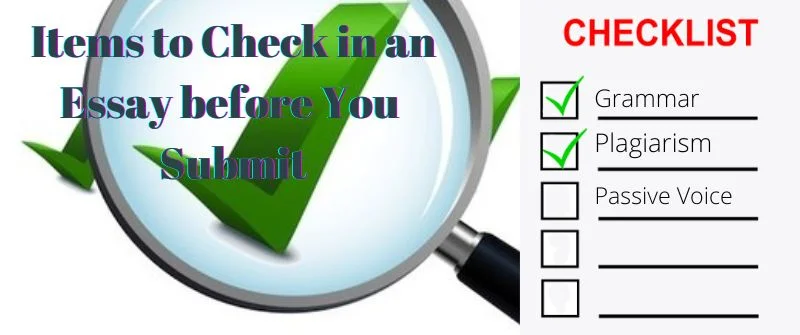
check my essay
Check My Essay Free From Grammar, Plagiarism, To Quality
How Long Is an Essay? The Ultimate Essay Length Guide
It’s safe to say that most students struggle with the word limit within an essay. Sometimes, it’s hard to find ideas for a text and meet the word requirement for every part of the paper. With so many factors influencing essay length, it’s easy to get confused.
Our specialists will write a custom essay specially for you!

Luckily, our custom-writing team has your back. In this article, our custom-writing experts will answer all your questions regarding essay length. We will also help you write papers with an ideal number of words!
📜 Is Essay Length Important?
📏 essay parts: recommended length.
- 🤔 How to Make Essays Shorter or Longer
- 📑 Essay Length & Formatting
- ❓ Different Academic Levels FAQ
- 📚 Essay Length: Different Types
- ⭐ Other Aspects
- 📝 Essay Examples
🔍 References
Often, the phrase “word limit” causes panic among students. After all, if an essay is too long or too short, your grade will be lowered. However, in reality, there’s nothing to worry about. When it comes to words, limitations are beneficial for both the students and the professors.
Let’s see what exactly it means.
Many people believe that the longer an essay is, the better. However, according to Frontiers, research shows that it’s a bias that couldn’t be further from the truth. A perfect-length paper is one that allows students to express their ideas and showcase their knowledge fully while keeping it clean and simple.
What Influences Essay Length
Various factors determine the length of an essay. Here are the most important ones:
Just in 1 hour! We will write you a plagiarism-free paper in hardly more than 1 hour
Let’s start with the essentials. Usually, assignment length is given as a number of words rather than pages. Unless your supervisor or instructor mentions any specific limitations, it’s acceptable to be 10% below or above the word limit.
It’s also worth knowing the 80/20 rule . According to it, the body should constitute 80% of the text, while the intro and the conclusion take up the remaining 20%.
Keep reading to learn more about the recommended length of each essay part. The main numbers are shown in the table below:
How Long Should an Introduction Be?
An introduction is the first section and the face of your essay. For that reason, it needs to be compelling and well-thought-out. Usually, it consists of 3 to 5 sentences or 50 to 80 words .
An introduction must have a hook, some background information, and a thesis statement. While the attention grabber and the thesis are usually brief, you may need 2 to 3 sentences for the background. To avoid going overboard, try to stay on topic and don’t add any filler.
Receive a plagiarism-free paper tailored to your instructions. Cut 15% off your first order!
How Long Is a Body Paragraph in an Essay?
The length of a body paragraph may vary. Sometimes, it can be limited to a single sentence. In other cases, it may take up a whole page. Usually, it’s recommended to have between 80 and 200 words (5-8 sentences) per body paragraph.
Since the paper’s body contains the most information, it’s necessary to explain and support your ideas properly. That’s why it’s no big deal if your body paragraphs go slightly over the word limit.
How Many Body Paragraphs Should Be in an Essay?
Like the word count, the number of paragraphs is determined by the type of paper and its topic. The minimum is 1. Generally, however, the body consists of 3-5 paragraphs , 1 for each argument.
To improve your paper’s structure, ensure that there are as many paragraphs as there are points in your thesis statement. Each one should have a purpose and support your arguments. If there’s any fluff, it’s better to get rid of it.
How Long Should a Conclusion Be?
Like the introduction, the conclusion consists of 50-80 words . It’s essential to keep it simple and only mention the central ideas. A weak concluding sentence may affect the reader’s understanding of the topic and spoil the overall impression of your paper.
Get an originally-written paper according to your instructions!
🤔 How to Make Essays Shorter or Longer: Best Tips
Undoubtedly the essay’s content is more important than the number of words you use. But there are times when students go more than 10-15% below or over the limit. Is there a solution to this problem?
Yes, there is! In this section, we will share the most useful tips to help you stay on point with your paper’s word count.
How to Make Essays Longer
Since having enough words is essential for a good grade, we’ve collected the best tips that can help you lengthen your essay without teachers noticing:
- Use relevant quotations. You don’t need to litter your essay with citations, but using them whenever appropriate is a great idea. For instance, if you’re working on a book analysis, referencing a couple of direct quotes from the source text will make your essay more credible and increase the word count.
- Give examples. Go through the claims in your paper and provide additional evidence where possible. It will make your essay longer and more informative.
- Use transitional expressions. Adding transition words and phrases is a natural way of increasing the number of words. It will also improve your essay’s readability.
- Add more references. Providing references is always a good idea when writing a formal essay. That way, you will increase the number of words and make your paper more credible.
- Work on your descriptions. If you struggle to develop new ideas, go over what you’ve already written and consider adding some descriptive words. It’s a great idea for creative essays to include more imagery.
How to Shorten an Essay
Another struggle of academic writing is cutting down the number of words in your essay to meet a set limit. We are here to tell you that it’s not that hard. Writing straightforwardly and keeping your sentences short is a key to concise content. Here are several strategies you may use to tighten a lengthy essay:
- Choose the active voice. It takes up less space than passive voice. Using it also makes your writing more professional and compelling.
- Remove needless transitions. Transitions can indeed maintain the flow of the paper. But some transitional phrases can be easily removed.
- Get rid of unnecessary adverbs and adjectives. Some students tend to overuse adjectives and adverbs. It adds wordiness to their writing.
- Avoid running starts. Some students like to start their sentences with long phrases like: “there are,” “it is believed,” or “the fact that.” Getting rid of them makes texts much more concise.
- Delete “that.” In most cases, the word “that” can often be easily removed from texts.
Another cool trick is to use our summarizing tool as essay shortener. Try it out!
📑 How Long Is an Essay Depending on Formatting?
As we mentioned earlier, the essay’s length is usually limited by the number of words. But sometimes, a teacher may ask you to write a specific number of pages. This is trickier because the amount of text you can place on the page depends on the formatting. By using the font size and spacing properly, it’s possible to make the paper visually longer or shorter. Let’s discuss it in more detail.

Essay Spacing: How Does It Affect the Length?
- Adjusting the spacing between lines. Try to make the changes as slight as possible. For instance, if you were asked to double-space the paper, use 2.1 or 2.2 spacing instead. Another option is to slightly extend spaces between paragraphs.
- Extending the margin size. You can increase the right and bottom margins by a quarter to make very subtle changes in length. For example, if the margins are 1 inch , you can set them at 1.25 inches instead.
- Increasing the spacing between characters. It is less noticeable than the line spacing. Still, try not to overdo it and keep the numbers between 1.2 and 1.5 .
- Adjusting the footer. Add a footer with page numbers to stretch the bottom margin even further.
- Lengthening the header. You can extend your header by adding your name, e-mail address, or other relevant information. Another option is double-spacing it.
Length of an Essay: Font and Size
- Using the right type of font. If your instructor didn’t specify which font you should use, go for the bigger ones. We suggest Arial, Bangla Sangam MN, Cambria, or Quicksand. They will make your text look longer without being too on the nose.
- Using a bigger font size. This is another technique that can come in handy. However, be careful and don’t increase your font by more than 0.1-0.5 pt.
- Increasing the size of periods and commas. This is one of the less noticeable tricks you can use. For instance, if your paper’s font is 12 pt. , increase it to 14 pt. only for punctuation marks. Italicizing periods and commas will also add several lines of length to your essay.
What to Do if There Are No Length Guidelines
Sometimes a teacher sets no word limit for a written work. What to do in that case? Well, first, you can ask your professor to confirm if they have simply forgotten to mention it. But if that’s not the case, here are a couple of helpful solutions:
- Think of the paragraph number. Sometimes, you may be given the number of paragraphs instead of words. In that case, you can decide on the number of words depending on how many paragraphs you have.
- Think about the topic’s complexity. The length of your paper is also directly dependent on the theme. If the topic is simple, 4-5 paragraphs will be enough. A more complex issue may require an in-depth explanation, so your essay can be 6-8 paragraphs long.
❓ Essay Length for Different Academic Levels FAQ
The length of the elementary school essay is usually short. Usually, a paper needs to have around 3-5 paragraphs, with 4-5 sentences per paragraph. Primary school essays can be 1-2 paragraphs long.
The word limit for a middle school essay is usually between 300 to 1000 words. The most common essay length is 500 words, which is about 5 paragraphs. However, it may differ from school to school.
The length of the high school essay may differ depending on the school and the complexity of the task itself. Usually, however, a paper can be between 300 to 1000 words long.
The length of the undergraduate college essay often falls within the range of 1500 to 2100 words. It translates into roughly 5-7 pages. 5 pages is the most common essay length at this level.
When it comes to the graduate school admission essay, the word limit is usually between 500 and 1000 words. It’s possible to go slightly over or below the set limit; however, it’s best to stick to the requirements as close as possible.
📚 How Long Should an Essay Be: Different Types
Now, let’s talk about different types of essays. How long should they be? Keep reading to learn about the length of college essays, short and extended ones, scholarship essays, and research papers.
How Long Is a College Essay?
When it comes to a college essay, it’s more important to stick to the word limit than with any other paper. Some teachers may refuse to read it unless it meets all the requirements.
The shortest limit for a college essay is about 250 words which is the shortest length of a Common App personal statement. It’s also rare to see a good college essay with over 650 words . So, an average piece usually has between 150 and 650 words ; you can go over or below the limit by 50.
How Long Is a Paragraph in College Essays?
A college essay usually consists of 4-5 paragraphs . One paragraph takes about 1/3 of the page, which is roughly 5 sentences . Each sentence corresponds with one of the following components:
- Topic sentence.
- Explanation.
- Transitions.
College Essay Length Requirements: Top 5 Schools
To understand the requirements for a college application essay even better, take a look at the table below. It showcases the top 5 schools and their length criteria for personal statements. Keep it in mind when writing your college essay:
How Long Is a Short Essay?
A short essay is usually 500 words long. Using 12pt Times New Roman font with standard margins and double spacing should result in about 2 pages of text.
Extended Essay Length
An extended essay is different from a short or a standard one. It requires extensive research and thorough explanation. That’s why the upper limit for this kind of essay is 4000 words . In this case, a typical essay length is 3500 words or 18 paragraphs .
Scholarship Essay Length
Generally, scholarship papers have a limit of 500 words , which is 1 page in length. Most scholarship programs provide additional requirements that indicate the minimum number of words or pages. If there are no set limitations, you can stick to the limit.
How Long Is a Research Paper?
Typically, a research paper is between 4000 and 6000 words long. Sometimes, there are shorter papers, which have around 2000 words, or in-depth ones with over 10000 words.
⭐ Other Aspects of Essay Length
When it comes to essay length, many different aspects come into play. Here, we’ve gathered all the essential information regarding an essay’s number of pages, paragraphs, words, and references.
How Many Paragraphs Are in an Essay?
Sometimes, it is more convenient to count paragraphs rather than words. Let’s now figure out how many paragraphs are in essays of different lengths. You may also check out the examples to see what such an essay looks like:
How to Count Paragraphs in an Essay Based on Word Count
You can also count the number of body paragraphs for your essay using the formula below:
Number of body paragraphs (average) = (TWC – TWC*0.16)/100
- TWC – total word count
- 0.16 – an average percentage of total word count for introduction and conclusion
- 100 – an average number of words per paragraph
How Many Pages Are in an Essay?
The number of pages in your essay may vary from subject to subject. But it’s still possible to determine the number of pages based on word count. Check out the numbers below to see the conversions with bonus examples:
You can also use a specialized calculator such as Word Counter to determine a number of pages in your essay.
What Does an Essay Look Like when Typed?
You might be wondering: what do essays of different lengths look like when typed? Well, here’s the table where you can find out the metrics for single- and double-spaced papers.
How Many Pages Are in a Handwritten Essay?
In case you need to turn in a handwritten paper, you should check out the table below.
Counting Words in a Handwritten Essay
If you don’t have enough time to count the words in your handwritten essay one by one, here’s what you can do:
- Count how many words there are in one line. Take the first and last lines and a line in the middle of a page. Let’s say there are 15, 14, and 15 words in them. Then, the average number of words per line is 15.
- Next, count how many lines there are on one page. Let’s say there are 17 lines on a page.
- Take the number of words per line and multiply it by the number of lines per page. In our case, we multiply 15 by 17. So, there are 255 words per page on average.
- Finally, multiply the number of words per page by the number of pages. If your essay has 3 pages, it is approximately 765 words long.
How Long Does it Take to Write an Essay?
It is crucial to know how long writing will take you, especially if you are working on an exam essay or just short on time. Note that you need to consider the time for typing and researching necessary to complete a piece. Research time may vary. Usually, it’s 1-2 hours for 200-250 words .
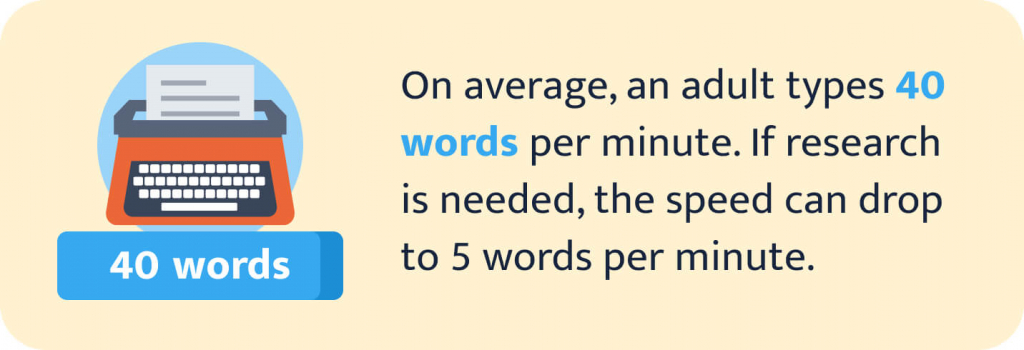
Below, we’ve gathered the average writing time for average and slower writing speed:
And here are the results in pages:
How Many References Does an Essay Need?
Another essential part of any composition is the reference list. Different academic levels require different references. You’ll find out how many of them should be in your paper in the table below!
📝 Essay Examples: Different Length
Finally, we’ve gathered some excellent sample essays of different lengths. Make sure to check them out!
We also recommend you check out our free essay samples sorted by pages:
- 1-Page Essay Examples
- 2-Page Essay Examples
- 3-Page Essay Examples
- 4-Page Essay Examples
- 5-Page Essay Examples
- 10-Page Essay Examples
- 20-Page Essay Examples
- 30-Page Essay Examples
- 40-Page Essay Examples
- 50-Page Essay Examples
Now you know all about essay length, word limits, and ways to lengthen or shorten your text. If you know other interesting tricks, make sure to share them in a comment! Good luck with your writing assignments!
You may also like:
- How to Write a Process Analysis Essay: Examples & Outline
- How to Write a Precis: Definition, Guide, & Examples
- How to Write a Critical Analysis Essay: Examples & Guide
- How to Write a Narrative Essay Outline: Template & Examples
- How to Write a Formal Essay: Format, Rules, & Example
- Word Limits and Assignment Length: Massey University
- The Paragraph in the College Essay: California State University, Long Beach
- Introductions & Conclusions: The University of Arizona Global Campus
- How Long Should a Paragraph Be?: Daily Writing Tips
- Paragraphing (Length Consistency): Purdue University
- Hitting the Target Word Count in Your College Admission Essay: Dummies.com
- How Long Should Your College Essay Be? What is the Ideal Length?: College Vine
- Writing Personal Statements Online: Issues of Length and Form: Penn State University
- Pen Admissions: Essays: University of Pennsylvania
- Essay Questions: University of Michigan
- Essay Structure: Harvard University
- Components of a Good Essay: University of Evansville
- Write Your Essay: UNSW Sydney
- College Writing: University of North Carolina at Chapel Hill
- 21 Helpful and Easy Tips to Make an Essay Longer: Seventeen
- How to Make a College Paper Longer: ThoughtCo
- Share to Facebook
- Share to Twitter
- Share to LinkedIn
- Share to email
![how to write a very long essay How to Get Perfect Letters of Recommendation for College [Guide]](https://custom-writing.org/blog/wp-content/uploads/2022/08/NA_SEP._14-284x153.jpg)
Do you dream of being successfully admitted to college? Well, you probably know that admission is a long process that includes many challenging steps. One of them is a recommendation letter: a document written on your behalf that describes your characteristics as a student. If done well, such a letter...

Almost everyone feels insecure when they start working on their first resume. Suddenly there are lots of questions that need to be answered. What should I write? How should I write it? What should I include in my resume to make it more appealing? If you’re looking for answers to...
What’s the first thing we do when facing the unknown? We Google it, of course! Google is fundamental to our experience of the Internet. According to the statistics, more than 100 000 people press “search” on Google every second! At first glance, the process is straightforward. You type in what...
![how to write a very long essay Top 25 Gadgets You Need to Study Smarter [from $20]](https://custom-writing.org/blog/wp-content/uploads/2022/06/sad-female-workaholic-keeps-hands-chin-busy-making-project-work-studies-papers-wears-elegant-white-shirt-sits-desktop-unknown-people-stretch-hands-with-notes-alarm-clock-smartphone-1-284x153.jpg)
Ever heard of a smart egg tray? Welcome to 2024! Today, there are gadgets for everything, and the variety of intelligent devices available increases every day. Some of them can improve your life. Others seem a bit useless. Will a smart egg tray actually add value to your life, or...

Dorms become like a second home to many students during their university experience. And while dorm life can mean making new friends and having exciting adventures, adjusting to new routines is not always easy. Since most students who come to the dorms have no prior experience living outside their parents’...

Imagine you’ve just written a paper. You’re going to proofread it, right? But is proofreading enough to ensure the absence of any factual errors or unfounded conclusions? Can you say with 100% certainty that you cited every reference correctly? If you want to learn how to fact-check like a pro,...

Every year, millions of U.S. students decide which university they want to attend. Around 20% of students rely on college rankings to make their final decision. Over the last two decades, such rankings have significantly grown in popularity. But are these lists reliable? Which criteria can be trusted? And which...

Have you ever seen someone else’s success and thought to yourself: “Why can’t I do the same?” What was your thought process like? Perhaps you believed you lacked some innate quality. Or did you think you could have achieved the same thing if you had put in enough effort? The difference in these attitudes is defined by two distinct mindsets—growth or fixed. You will read all about them in this article by Custom-Writing.org. You’ll also...

Are you interested in having a side hustle? If you have a hobby you are passionate about, look no further. A hobby-based side hustle is a great way to spend time doing something you love, a great source of income, and a way to boost your resume! In this article by Custom-Writing.org, you will find: a list of 7 inexpensive hobbies available to anyone; ways to monetize them; their benefits for...

In 2024, online education remains one of the most searched terms. Not only can you undertake short courses, but it is now commonplace to get Bachelor’s and Master’s degrees online. Is this the right fit for you? Keep reading to find out! In this article, our custom writing team will:...

What is the number one reason for becoming a volunteer? You may already know that charitable organizations help people in need and allow everyone to make a difference. However, there are some material benefits as well. Volunteer experience can boost your career prospects: it increases your chances of getting into...

Are you excited about grammar? Have you ever read the dictionary for fun? Do you become enthralled by your textbooks? Whether you are a language nerd or not, crossword puzzles are here to help. In this article, you will find dozens of exciting puzzle resources to support your learning. You...
Get science-backed answers as you write with Paperpal's Research feature
How to Write an Essay Introduction (with Examples)

The introduction of an essay plays a critical role in engaging the reader and providing contextual information about the topic. It sets the stage for the rest of the essay, establishes the tone and style, and motivates the reader to continue reading.
Table of Contents
What is an essay introduction , what to include in an essay introduction, how to create an essay structure , step-by-step process for writing an essay introduction , how to write an introduction paragraph , how to write a hook for your essay , how to include background information , how to write a thesis statement .
- Argumentative Essay Introduction Example:
- Expository Essay Introduction Example
Literary Analysis Essay Introduction Example
Check and revise – checklist for essay introduction , key takeaways , frequently asked questions .
An introduction is the opening section of an essay, paper, or other written work. It introduces the topic and provides background information, context, and an overview of what the reader can expect from the rest of the work. 1 The key is to be concise and to the point, providing enough information to engage the reader without delving into excessive detail.
The essay introduction is crucial as it sets the tone for the entire piece and provides the reader with a roadmap of what to expect. Here are key elements to include in your essay introduction:
- Hook : Start with an attention-grabbing statement or question to engage the reader. This could be a surprising fact, a relevant quote, or a compelling anecdote.
- Background information : Provide context and background information to help the reader understand the topic. This can include historical information, definitions of key terms, or an overview of the current state of affairs related to your topic.
- Thesis statement : Clearly state your main argument or position on the topic. Your thesis should be concise and specific, providing a clear direction for your essay.
Before we get into how to write an essay introduction, we need to know how it is structured. The structure of an essay is crucial for organizing your thoughts and presenting them clearly and logically. It is divided as follows: 2
- Introduction: The introduction should grab the reader’s attention with a hook, provide context, and include a thesis statement that presents the main argument or purpose of the essay.
- Body: The body should consist of focused paragraphs that support your thesis statement using evidence and analysis. Each paragraph should concentrate on a single central idea or argument and provide evidence, examples, or analysis to back it up.
- Conclusion: The conclusion should summarize the main points and restate the thesis differently. End with a final statement that leaves a lasting impression on the reader. Avoid new information or arguments.

Here’s a step-by-step guide on how to write an essay introduction:
- Start with a Hook : Begin your introduction paragraph with an attention-grabbing statement, question, quote, or anecdote related to your topic. The hook should pique the reader’s interest and encourage them to continue reading.
- Provide Background Information : This helps the reader understand the relevance and importance of the topic.
- State Your Thesis Statement : The last sentence is the main argument or point of your essay. It should be clear, concise, and directly address the topic of your essay.
- Preview the Main Points : This gives the reader an idea of what to expect and how you will support your thesis.
- Keep it Concise and Clear : Avoid going into too much detail or including information not directly relevant to your topic.
- Revise : Revise your introduction after you’ve written the rest of your essay to ensure it aligns with your final argument.
Here’s an example of an essay introduction paragraph about the importance of education:
Education is often viewed as a fundamental human right and a key social and economic development driver. As Nelson Mandela once famously said, “Education is the most powerful weapon which you can use to change the world.” It is the key to unlocking a wide range of opportunities and benefits for individuals, societies, and nations. In today’s constantly evolving world, education has become even more critical. It has expanded beyond traditional classroom learning to include digital and remote learning, making education more accessible and convenient. This essay will delve into the importance of education in empowering individuals to achieve their dreams, improving societies by promoting social justice and equality, and driving economic growth by developing a skilled workforce and promoting innovation.
This introduction paragraph example includes a hook (the quote by Nelson Mandela), provides some background information on education, and states the thesis statement (the importance of education).
This is one of the key steps in how to write an essay introduction. Crafting a compelling hook is vital because it sets the tone for your entire essay and determines whether your readers will stay interested. A good hook draws the reader in and sets the stage for the rest of your essay.
- Avoid Dry Fact : Instead of simply stating a bland fact, try to make it engaging and relevant to your topic. For example, if you’re writing about the benefits of exercise, you could start with a startling statistic like, “Did you know that regular exercise can increase your lifespan by up to seven years?”
- Avoid Using a Dictionary Definition : While definitions can be informative, they’re not always the most captivating way to start an essay. Instead, try to use a quote, anecdote, or provocative question to pique the reader’s interest. For instance, if you’re writing about freedom, you could begin with a quote from a famous freedom fighter or philosopher.
- Do Not Just State a Fact That the Reader Already Knows : This ties back to the first point—your hook should surprise or intrigue the reader. For Here’s an introduction paragraph example, if you’re writing about climate change, you could start with a thought-provoking statement like, “Despite overwhelming evidence, many people still refuse to believe in the reality of climate change.”
Including background information in the introduction section of your essay is important to provide context and establish the relevance of your topic. When writing the background information, you can follow these steps:
- Start with a General Statement: Begin with a general statement about the topic and gradually narrow it down to your specific focus. For example, when discussing the impact of social media, you can begin by making a broad statement about social media and its widespread use in today’s society, as follows: “Social media has become an integral part of modern life, with billions of users worldwide.”
- Define Key Terms : Define any key terms or concepts that may be unfamiliar to your readers but are essential for understanding your argument.
- Provide Relevant Statistics: Use statistics or facts to highlight the significance of the issue you’re discussing. For instance, “According to a report by Statista, the number of social media users is expected to reach 4.41 billion by 2025.”
- Discuss the Evolution: Mention previous research or studies that have been conducted on the topic, especially those that are relevant to your argument. Mention key milestones or developments that have shaped its current impact. You can also outline some of the major effects of social media. For example, you can briefly describe how social media has evolved, including positives such as increased connectivity and issues like cyberbullying and privacy concerns.
- Transition to Your Thesis: Use the background information to lead into your thesis statement, which should clearly state the main argument or purpose of your essay. For example, “Given its pervasive influence, it is crucial to examine the impact of social media on mental health.”

A thesis statement is a concise summary of the main point or claim of an essay, research paper, or other type of academic writing. It appears near the end of the introduction. Here’s how to write a thesis statement:
- Identify the topic: Start by identifying the topic of your essay. For example, if your essay is about the importance of exercise for overall health, your topic is “exercise.”
- State your position: Next, state your position or claim about the topic. This is the main argument or point you want to make. For example, if you believe that regular exercise is crucial for maintaining good health, your position could be: “Regular exercise is essential for maintaining good health.”
- Support your position: Provide a brief overview of the reasons or evidence that support your position. These will be the main points of your essay. For example, if you’re writing an essay about the importance of exercise, you could mention the physical health benefits, mental health benefits, and the role of exercise in disease prevention.
- Make it specific: Ensure your thesis statement clearly states what you will discuss in your essay. For example, instead of saying, “Exercise is good for you,” you could say, “Regular exercise, including cardiovascular and strength training, can improve overall health and reduce the risk of chronic diseases.”
Examples of essay introduction
Here are examples of essay introductions for different types of essays:
Argumentative Essay Introduction Example:
Topic: Should the voting age be lowered to 16?
“The question of whether the voting age should be lowered to 16 has sparked nationwide debate. While some argue that 16-year-olds lack the requisite maturity and knowledge to make informed decisions, others argue that doing so would imbue young people with agency and give them a voice in shaping their future.”
Expository Essay Introduction Example
Topic: The benefits of regular exercise
“In today’s fast-paced world, the importance of regular exercise cannot be overstated. From improving physical health to boosting mental well-being, the benefits of exercise are numerous and far-reaching. This essay will examine the various advantages of regular exercise and provide tips on incorporating it into your daily routine.”
Text: “To Kill a Mockingbird” by Harper Lee
“Harper Lee’s novel, ‘To Kill a Mockingbird,’ is a timeless classic that explores themes of racism, injustice, and morality in the American South. Through the eyes of young Scout Finch, the reader is taken on a journey that challenges societal norms and forces characters to confront their prejudices. This essay will analyze the novel’s use of symbolism, character development, and narrative structure to uncover its deeper meaning and relevance to contemporary society.”
- Engaging and Relevant First Sentence : The opening sentence captures the reader’s attention and relates directly to the topic.
- Background Information : Enough background information is introduced to provide context for the thesis statement.
- Definition of Important Terms : Key terms or concepts that might be unfamiliar to the audience or are central to the argument are defined.
- Clear Thesis Statement : The thesis statement presents the main point or argument of the essay.
- Relevance to Main Body : Everything in the introduction directly relates to and sets up the discussion in the main body of the essay.

Writing a strong introduction is crucial for setting the tone and context of your essay. Here are the key takeaways for how to write essay introduction: 3
- Hook the Reader : Start with an engaging hook to grab the reader’s attention. This could be a compelling question, a surprising fact, a relevant quote, or an anecdote.
- Provide Background : Give a brief overview of the topic, setting the context and stage for the discussion.
- Thesis Statement : State your thesis, which is the main argument or point of your essay. It should be concise, clear, and specific.
- Preview the Structure : Outline the main points or arguments to help the reader understand the organization of your essay.
- Keep it Concise : Avoid including unnecessary details or information not directly related to your thesis.
- Revise and Edit : Revise your introduction to ensure clarity, coherence, and relevance. Check for grammar and spelling errors.
- Seek Feedback : Get feedback from peers or instructors to improve your introduction further.
The purpose of an essay introduction is to give an overview of the topic, context, and main ideas of the essay. It is meant to engage the reader, establish the tone for the rest of the essay, and introduce the thesis statement or central argument.
An essay introduction typically ranges from 5-10% of the total word count. For example, in a 1,000-word essay, the introduction would be roughly 50-100 words. However, the length can vary depending on the complexity of the topic and the overall length of the essay.
An essay introduction is critical in engaging the reader and providing contextual information about the topic. To ensure its effectiveness, consider incorporating these key elements: a compelling hook, background information, a clear thesis statement, an outline of the essay’s scope, a smooth transition to the body, and optional signposting sentences.
The process of writing an essay introduction is not necessarily straightforward, but there are several strategies that can be employed to achieve this end. When experiencing difficulty initiating the process, consider the following techniques: begin with an anecdote, a quotation, an image, a question, or a startling fact to pique the reader’s interest. It may also be helpful to consider the five W’s of journalism: who, what, when, where, why, and how. For instance, an anecdotal opening could be structured as follows: “As I ascended the stage, momentarily blinded by the intense lights, I could sense the weight of a hundred eyes upon me, anticipating my next move. The topic of discussion was climate change, a subject I was passionate about, and it was my first public speaking event. Little did I know , that pivotal moment would not only alter my perspective but also chart my life’s course.”
Crafting a compelling thesis statement for your introduction paragraph is crucial to grab your reader’s attention. To achieve this, avoid using overused phrases such as “In this paper, I will write about” or “I will focus on” as they lack originality. Instead, strive to engage your reader by substantiating your stance or proposition with a “so what” clause. While writing your thesis statement, aim to be precise, succinct, and clear in conveying your main argument.
To create an effective essay introduction, ensure it is clear, engaging, relevant, and contains a concise thesis statement. It should transition smoothly into the essay and be long enough to cover necessary points but not become overwhelming. Seek feedback from peers or instructors to assess its effectiveness.
References
- Cui, L. (2022). Unit 6 Essay Introduction. Building Academic Writing Skills .
- West, H., Malcolm, G., Keywood, S., & Hill, J. (2019). Writing a successful essay. Journal of Geography in Higher Education , 43 (4), 609-617.
- Beavers, M. E., Thoune, D. L., & McBeth, M. (2023). Bibliographic Essay: Reading, Researching, Teaching, and Writing with Hooks: A Queer Literacy Sponsorship. College English, 85(3), 230-242.
Paperpal is a comprehensive AI writing toolkit that helps students and researchers achieve 2x the writing in half the time. It leverages 21+ years of STM experience and insights from millions of research articles to provide in-depth academic writing, language editing, and submission readiness support to help you write better, faster.
Get accurate academic translations, rewriting support, grammar checks, vocabulary suggestions, and generative AI assistance that delivers human precision at machine speed. Try for free or upgrade to Paperpal Prime starting at US$19 a month to access premium features, including consistency, plagiarism, and 30+ submission readiness checks to help you succeed.
Experience the future of academic writing – Sign up to Paperpal and start writing for free!
Related Reads:
- What is an Argumentative Essay? How to Write It (With Examples)
- How to Paraphrase Research Papers Effectively
- How to Cite Social Media Sources in Academic Writing?
- How Long Should a Chapter Be?
Similarity Checks: The Author’s Guide to Plagiarism and Responsible Writing
Types of plagiarism and 6 tips to avoid it in your writing , you may also like, 4 ways paperpal encourages responsible writing with ai, what are scholarly sources and where can you..., how to write a hypothesis types and examples , what is academic writing: tips for students, what is hedging in academic writing , how to use ai to enhance your college..., how to use paperpal to generate emails &..., ai in education: it’s time to change the..., is it ethical to use ai-generated abstracts without..., do plagiarism checkers detect ai content.
- PRO Courses Guides New Tech Help Pro Expert Videos About wikiHow Pro Upgrade Sign In
- EDIT Edit this Article
- EXPLORE Tech Help Pro About Us Random Article Quizzes Request a New Article Community Dashboard This Or That Game Popular Categories Arts and Entertainment Artwork Books Movies Computers and Electronics Computers Phone Skills Technology Hacks Health Men's Health Mental Health Women's Health Relationships Dating Love Relationship Issues Hobbies and Crafts Crafts Drawing Games Education & Communication Communication Skills Personal Development Studying Personal Care and Style Fashion Hair Care Personal Hygiene Youth Personal Care School Stuff Dating All Categories Arts and Entertainment Finance and Business Home and Garden Relationship Quizzes Cars & Other Vehicles Food and Entertaining Personal Care and Style Sports and Fitness Computers and Electronics Health Pets and Animals Travel Education & Communication Hobbies and Crafts Philosophy and Religion Work World Family Life Holidays and Traditions Relationships Youth
- Browse Articles
- Learn Something New
- Quizzes Hot
- This Or That Game
- Train Your Brain
- Explore More
- Support wikiHow
- About wikiHow
- Log in / Sign up
- Education and Communications
- Study Skills
- Memorization Skills
How to Memorise Long Text in the Shortest Amount of Time Possible
Last Updated: August 19, 2023 References
This article was co-authored by Alexander Ruiz, M.Ed. and by wikiHow staff writer, Jennifer Mueller, JD . Alexander Ruiz is an Educational Consultant and the Educational Director of Link Educational Institute, a tutoring business based in Claremont, California that provides customizable educational plans, subject and test prep tutoring, and college application consulting. With over a decade and a half of experience in the education industry, Alexander coaches students to increase their self-awareness and emotional intelligence while achieving skills and the goal of achieving skills and higher education. He holds a BA in Psychology from Florida International University and an MA in Education from Georgia Southern University. There are 14 references cited in this article, which can be found at the bottom of the page. This article has been viewed 404,400 times.
If you've ever tried to memorize an essay, monologue, long answer, or other text, you likely just repeated the words over and over again until you could recite them from rote memory. However, this isn't necessarily the quickest way to memorize something and if you're working with a longer text you may not have the time it would take to keep repeating it aloud. Instead, use memorization techniques that suit your learning style and focus on recalling the text rather than rote memorization. [1] X Research source
Breaking the Text into Chunks

- For example, if you're trying to memorize Abraham Lincoln's Gettysburg Address, your first chunk might be the first line of the speech, in which Lincoln talks about the founding of the United States. The second chunk might relate to Lincoln's description of the civil war, then the third to the battlefield Lincoln was consecrating that day. Despite being separate chunks, the second and third chunks make up the same paragraph. [3] X Research source
- Look for phrases you already know that you won't have to work as hard to commit to memory. For example, if you already remember the phrase "four score and seven years ago" from the Gettysburg Address, you don't need to worry about memorizing that.
- Sometimes it can also help to reformat the text. You might hand-write or type the text out with plenty of space between the chunks. You might even include separate headings for each of the chunks.

- Get a good familiarity with each of the chunks separately before you start to combine them. If there is a particular area of your original chunk that's giving you trouble, try separating it into even smaller chunks. Then you can combine those smaller chunks together once you've got them down.

- Practice the first and second chunk together until you can recite them flawlessly. Then you're ready to add the third chunk.

- If you run into rough spots, stop and go back over them until you can recite them smoothly. Then integrate that part into the rest of the chunk.
- Throughout the process, keep your eye out for transitions that you can use as triggers to combine the chunks together seamlessly. If these transitions aren't in the text, add them mentally to help you connect the chunks — just remember not to say them out loud.
Creating a Memory Palace

- It's often easiest to use your home, since you're intimately familiar with the rooms and the objects inside.
- Your place can also be a fictitious place that you're deeply familiar with. For example, if you're a big fan of Harry Potter and have a familiar map in your head of Hogwarts, you could use that.
- Your "memory palace" doesn't have to be a single building or location. It can also be a route from one place to another. For example, you might use your route from home to work or school.

- For example, if you're trying to memorize Hamlet's soliloquy, you might imagine a letter "B" on the door of a room. When you open the room, there are arrows and slingshots pelting you from a large bag of gold coins. If you close the door and move down the hall, there are arms reaching out that grab you and carry you across a turbulent ocean. [8] X Research source

- If you encounter pieces that are difficult to remember, you may want to rethink the object you have associated with that piece or break it up into smaller pieces associated with multiple objects.

- This technique may take some practice to master. If you're up against a deadline, it may not be the best time to create a memory palace. However, once you've used it a few times, you may find it enables you to memorize text more quickly.
- If you used a route rather than a place, you can travel through the text you're trying to memorize every day as you head to work or school. You could even try it in reverse as you go back home. Then you'd be able to say you know the text "backward and forward."
Trying Other Memorization Techniques

- For example, if you were trying to memorize Hamlet's soliloquy from Shakespeare's Hamlet, you would write "t b, o n t b? t i t q — w 't n i t m t s t s a a o o f, o t t a a a s o t, a, b o, e t?" [11] X Research source Then you would see how many words you could get just from those first letters.
- Circle the letters that correspond to words you couldn't remember and then go back to the text. Use your favorite memorization technique to better commit those words to your memory in the context of the text, then try the first letters again.
- This trick is also useful if you're trying to recall something you memorized a long time ago but haven't thought about since. You might be surprised how much you'll recall.

- If you're musically inclined, you could try recording yourself playing the song. You may also be able to find an instrumental version of the song on your favorite streaming service.
- Educational programs, such as "Schoolhouse Rock," often create songs for historical documents and speeches. Search the internet or your favorite video streaming service and see what you can find.

- Feel free to gesticulate as well to really get into the emotion of the text. The more passion and emotion you attach to it, the better you'll be able to remember it.

- For example, if you were trying to memorize Abraham Lincoln's Gettysburg Address, you might think of an image of your father, an image of the United States, an image of the Statue of Liberty, and an equal sign to represent the first line: "Four score and seven years ago our fathers brought forth on this continent a new nation, conceived in Liberty, and dedicated to the proposition that all men are created equal."
- If you enjoy emoji, you might try "translating" the text into emoji. Since those images are already familiar to you, it might make the text easier to remember.

- If you dislike the sound of your own voice, you can always get someone else to read the text for you. However, you'll get less of a benefit by listening to someone else's voice than you would if you listened to your own voice.
- If you're trying to memorize a relatively famous text, you may also be able to find recordings online of famous actors or other celebrities reading the text.
Expert Q&A

- Once you've found a method that works for you, practice it by memorizing speeches, monologues, or essays that spark your interest. The more you practice memorizing things, the better you'll get. Thanks Helpful 1 Not Helpful 0
- After you've memorized something, make an effort to recite it at least once every few days so it sticks in your memory. Thanks Helpful 0 Not Helpful 0

You Might Also Like

- ↑ https://www.backstage.com/magazine/article/backstage-experts-answer-ways-quickly-memorize-lines-6719/
- ↑ https://www.facinghistory.org/resource-library/teaching-strategies/chunking
- ↑ http://www.abrahamlincolnonline.org/lincoln/speeches/gettysburg.htm
- ↑ https://psychcentral.com/lib/memory-and-mnemonic-devices/
- ↑ https://courses.lumenlearning.com/boundless-psychology/chapter/step-1-memory-encoding/
- ↑ https://www.ncbi.nlm.nih.gov/pmc/articles/PMC4056179/
- ↑ https://www.poetryfoundation.org/poems/56965/speech-to-be-or-not-to-be-that-is-the-question
- ↑ https://learningcenter.unc.edu/tips-and-tools/enhancing-your-memory/
- ↑ http://www.productivity501.com/how-to-memorize-verbatim-text/294/
- ↑ https://poets.org/poem/hamlet-act-iii-scene-i-be-or-not-be
- ↑ https://blogs.unimelb.edu.au/sciencecommunication/2017/10/20/want-to-remember-something-better-put-it-in-a-song/
- ↑ https://www.nyfa.edu/student-resources/7-easy-monologue-memorization-tips/
- ↑ Alexander Ruiz, M.Ed.. Educational Consultant. Expert Interview. 18 June 2020.
- ↑ https://www.tandfonline.com/doi/abs/10.1080/09658211.2017.1383434
About This Article

To memorize a long text in the shortest time possible, start by splitting it into 1-2 sentence sections to make it easier to remember. Read the first section a few times. Then, cover the page and practice recalling the section from memory. You can say it aloud, in your head, or write it down on a new piece of paper. Once you’ve memorized the first section, move onto the next one. Whenever you start a new section, say or write the text from the beginning so you learn the flow between each section. Repeat the process until you’ve learned all of the sections of your text. For more tips, including how to memorize text by using pictures for each section, read on! Did this summary help you? Yes No
- Send fan mail to authors
Reader Success Stories
Beatriz Carvalho
Jun 30, 2016
Did this article help you?
Sep 5, 2017
Sep 3, 2017
Mayflower Summer
Jun 19, 2016
Vito Buller
Apr 5, 2016

Featured Articles

Trending Articles

Watch Articles

- Terms of Use
- Privacy Policy
- Do Not Sell or Share My Info
- Not Selling Info
Don’t miss out! Sign up for
wikiHow’s newsletter

How to Write an Essay – Best Method Explained
B efore we dive into this article, we highly recommend you check out bestessaywriter.net if you are looking to get your essay written by highly qualified writers with over 30 years of experience.
Are you passionate about a topic and eager to share it? Write an essay! Do you disagree with a common viewpoint and want to persuade others to see it your way? Write an essay! Are you required to submit a piece of writing to get into your dream college? Write an essay!
Writing essays is a powerful way to express your thoughts, challenge prevailing opinions, and fulfill academic requirements. Whether you're driven by passion or necessity, crafting a well-thought-out essay can make a significant impact.
The term "essay" broadly describes any written piece where the author presents their viewpoint on a topic. This can be academic, editorial, or even humorous in nature. Despite the vast number of approaches and topics available, successful essay writing generally adheres to a consistent framework.
Good essays are structured effectively to guide the reader through the author's arguments and insights. Whether you're exploring complex theories or sharing personal experiences, a clear, logical structure is key to making your essay compelling and coherent.
In the following sections, we'll dive into that framework and explain how you can apply it to your essays, regardless of their type. But first, let's begin with a basic overview of essay writing.
How to Write an Essay
If you are having trouble writing an essay, you can hire an essay writer from BestEssayWriter.net but if you want to learn how to write an essay on your own, we will lay down the exact steps in this guide.
Steps to write an essay:
- Generate Ideas and Choose a Type of Essay : Start by brainstorming potential topics and deciding on the type of essay you want to write, whether it's persuasive, descriptive, expository, or another style.
- Outline Your Essay : Plan your essay by outlining each paragraph. This helps organize your thoughts and ensures a logical flow of information.
- Write a Rough Draft : Begin with a rough draft, focusing on getting your ideas down on paper. Don't worry about perfect word choice or grammar at this stage.
- Edit and Revise : After completing your rough draft, go back and refine it. Pay attention to details like word choice, sentence structure, and overall coherence.
- Proofread : Finally, review your essay for any typos, errors, or other issues that might detract from your message.
We'll explore each of these steps in more detail below, but first, let's focus on a crucial element of any effective essay: choosing the right topic.
Crafting Your Essay's Thesis Statement
Before you start writing your essay, there are three critical aspects to consider:
- Thesis
- Type
- Audience
Among these, the thesis is the most crucial. It represents the core argument or main point of your essay. For instance, Bertrand Russell's thesis in "In Praise of Idleness" argues that society overly prioritizes work, neglecting the value of leisure.
Your thesis statement should encapsulate this central idea. It's what you want your readers to remember most when they finish reading. If you're struggling to define your thesis, ask yourself: "What's the one thing I want my readers to remember?"
It's best to state your thesis early, ideally in the first few sentences, and to reiterate it throughout your essay, particularly in the conclusion. This repetition ensures that your central idea is clear and resonant.
The rest of your essay should support this thesis. You can use various forms of evidence to bolster your argument, including empirical data, testimonials, logical reasoning, or persuasive language. The key is to consistently build upon your initial thesis without veering off into unrelated topics.
The Essay-Writing Process
Writing encompasses a range of formats, from essays and research papers to novels, poems, screenplays, and blog articles. No matter the format, following an efficient writing process is essential. Even if you begin with a stream-of-consciousness style for your rough draft, a structured system is crucial for revision and refinement.
Here’s a five-step writing process recommended for essay writing:
- Brainstorming : Start by gathering your thoughts. Based on your prompt or thesis, generate as many ideas as you can. This is your chance to think freely and note down everything that comes to mind, knowing you can later discard what doesn’t fit.
- Preparing : In this stage, you filter and organize your ideas. Select those that best support your thesis and arrange them logically. This phase also involves outlining your essay’s structure and gathering resources for evidence. If your essay requires citations, now is the time to collect these, following the appropriate style guide (MLA, APA, or Chicago) depending on your academic or publication requirements.
- Drafting : Now, you write your first draft. Don’t aim for perfection. The goal is to get your ideas down on paper. Focusing too much on perfecting each word can detract from the overall flow of your essay.
- Revising : This involves multiple drafts. Here, refine your essay by enhancing word choice, clarity, and overall flow. Avoid common pitfalls like passive voice and run-on sentences. Tools like Grammarly can be particularly helpful in this stage, offering suggestions for sentence structure and clarity to ensure your writing is concise and readable.
- Proofreading : After revising, the final step is proofreading. This is your chance to catch any misspellings, grammatical errors, or formatting issues. Using a tool like Grammarly’s AI-powered writing assistant can be beneficial for catching these common mistakes, providing instant feedback to refine your essay further.
This structured approach helps maintain focus throughout the writing process, ensuring that each part of your essay contributes effectively to the whole.
Essay Structure: An Overview
The structure of an essay typically adheres to a simple format of introduction, body, and conclusion. However, the content within these sections is what truly makes an essay effective.
Introduction : The introduction sets the stage for your essay. It follows general writing guidelines but places extra emphasis on presenting the thesis statement prominently, ideally within the first few sentences. By the end of your introductory paragraph, the reader should clearly understand the topic of your essay. Following conventional best practices for writing an introduction will ensure a strong start.
Body Paragraphs : The body forms the bulk of your essay. Here, each paragraph supports your thesis with evidence. How you organize these paragraphs is crucial. In cases where arguments build on each other, a logical progression ensures clarity and enhances the reader's understanding. It's important to remember that the reader may not be as familiar with the subject as you are, so the structure should aid their comprehension.
When writing an argumentative essay, the organization of points can vary. You might start with your own argument, presenting evidence before introducing opposing views, or you might begin by addressing the opposition's views and then refute them. The arrangement depends on the strategy you choose:
- Aristotelian (Classical) : Focuses on establishing the validity of your position.
- Rogerian : Acknowledges the opposing perspectives before presenting a middle ground.
- Toulmin : Breaks down arguments into their fundamental parts, including counter-arguments and supporting evidence.
For simpler essays, a straightforward approach can be effective:
- Your Point : Clearly state your argument.
- Counterpoint : Introduce opposing viewpoints.
- Evidence : Provide evidence that supports your point and/or refutes the counterpoint.
This basic framework ensures that your essay is not only structured and coherent but also persuasive and comprehensive.
Conclusion: Wrapping Up Your Essay
The conclusion of an essay serves to effectively summarize and reinforce your thesis, making it digestible and memorable for the reader. It's the final opportunity to solidify your arguments and leave a lasting impression.
A good conclusion will:
- Restate the Thesis : Reiterate your main argument to remind the reader of its importance and relevance.
- Summarize Key Points : Briefly recap the major arguments or evidence presented in the body paragraphs to reinforce the thesis.
- Offer Closure : Provide a final statement that signals the essay is coming to an end, often linking back to the broader implications of your argument.
While it's tempting to introduce new ideas or fresh perspectives in the conclusion, it's important to avoid presenting new evidence or arguments that weren't previously discussed. Instead, you can:
- Provide Context : Expand on the implications of your thesis in a broader context, suggesting areas for further exploration or the potential impact of your findings.
- Reflect on the Journey : Acknowledge any changes in perspective or insights gained through the process of writing the essay.
The conclusion should leave the reader with a clear understanding of your central thesis and the confidence that the essay has fully explored and supported that thesis. By effectively wrapping up your essay, you ensure that your ideas resonate with the reader long after they finish reading.
The Five-Paragraph Essay: A Simple Structure
The five-paragraph essay is a straightforward and efficient structure ideal for short, time-constrained writing tasks. This format is especially useful during exams or when a quick response is required. Here’s how it breaks down:
- Introduction Paragraph : This is where you introduce the topic and present your thesis statement. The introduction sets the stage for the discussion and aims to grab the reader's interest.
- Three Body Paragraphs : Each paragraph should focus on a single main idea that supports your thesis, elaborated with examples, facts, or arguments. This is the core section where you develop your thesis and make your case to the reader.
- Conclusion Paragraph : The conclusion summarizes the main points and restates the thesis in light of the evidence presented. It should bring a sense of closure and completeness to the essay, reinforcing your initial argument and perhaps suggesting broader implications or future considerations.
While the five-paragraph essay structure may not accommodate more complex or nuanced topics, its simplicity and clarity make it highly effective for straightforward subjects and settings where clarity and brevity are essential. This structure ensures that your essay is organized and coherent, making it easier for the reader to follow and understand your points quickly.
Understanding Your Essay's Audience
Knowing who will read your essay is crucial—it influences everything from the tone to the complexity of your language. Your audience can range from a teacher or admissions counselor to your peers or a broader internet audience. Each group has different expectations and preferences that should guide how you write.
Formality : The level of formality required often depends on your readers. Academic and professional settings typically demand a formal tone, precise word choice, and a structured approach. In contrast, a blog post or a piece for your peers might allow for a more relaxed style.
Language and Style : Consider the familiarity of your audience with the subject matter. This understanding will determine how much background information you need to provide and how complex your vocabulary should be. For example, technical jargon might be appropriate for a specialist audience but confusing for general readers.
Use of Language Devices : Devices like emojis can enhance a casual piece by adding personality and aiding emotional expression. However, they are generally inappropriate in formal essays where they can seem unprofessional and out of place.
Tailoring your essay to your audience not only makes your writing more effective but also ensures that it is received and understood as intended. Whether you’re drafting a formal research paper or a casual blog post, considering your audience’s expectations will lead to clearer, more effective communication.
Exploring the Six Common Types of Essays
Essays can vary significantly in style and purpose, often dictated by the assignment or the writer's intent. Understanding the different types of essays can enhance your ability to choose the most effective approach for your writing. Here are six common types of essays that you might encounter:
Argumentative Essay
Argumentative essays are foundational in academic settings, primarily aiming to assert and defend a position. These essays require you to present a strong case for your viewpoint, making them a staple in many school assignments, especially in college.
Admissions Essay
Used in college applications, admissions essays ask you to explain why you are interested in a particular school. This type of essay is your opportunity to communicate your passion, goals, and suitability for a college program.
Persuasive Essay
Similar to argumentative essays, persuasive essays aim to convince the reader of a specific viewpoint. However, the key difference lies in the intent; persuasive essays not only present an argument but also seek to persuade the reader to adopt this perspective, often through emotional appeal and logical reasoning.
Compare-and-Contrast Essay
This format is ideal for discussing two opposing viewpoints or different aspects of a topic, giving equal attention to each. Compare-and-contrast essays are excellent for exploring the similarities and differences between two subjects, providing a balanced view without bias toward one side.
Personal Essay
Personal essays are narrative in nature, often relaying anecdotes or personal experiences. Writers like David Sedaris excel in this form, offering stories that resonate on a personal level. While these essays may have a thesis, it is often more interpretive, reflecting personal growth or insights.
Expository Essay
Expository essays are informative, explaining a topic in detail to enhance the reader's understanding. Unlike argumentative or persuasive essays, they maintain an objective tone, presenting facts without personal bias.
Each type of essay serves a different purpose and requires a specific approach. Whether you're arguing a point, sharing a personal story, or providing an objective explanation, understanding these distinctions can help you craft more effective, tailored content.
Enhancing Your Essay Writing Skills
Mastering the fundamentals .
To excel in essay writing, especially in academic settings, mastering the fundamentals is crucial. Understanding essay structure and the writing process is essential, but your ability to apply these concepts is what will truly make your essays stand out. Focus on developing your thesis logically and coherently, using an appropriate language style, and ensuring that your references and citations are reliable. For advanced tips that build on these basics, consider exploring more detailed guides on improving your essay skills.
Getting Feedback
One of the best ways to improve your writing is to seek feedback. Having someone else review your work can provide new insights and catch errors that you might have missed. This is because working on the same piece can lead to tunnel vision. If possible, exchange essays with a friend for mutual editing, utilize writing centers, or join online writing communities. If these options aren't available, taking a break and revisiting your work with fresh eyes can also be very beneficial.
The Importance of Grammar and Form
How you present your ideas can be as important as the ideas themselves. Even a strong, clear thesis can be undermined by poor grammar, confusing structure, or unclear writing. For essays that need to make a strong impact, consider tools like Grammarly Premium, which offers sentence restructuring for clarity, grammar corrections, and readability enhancements. These tools are also invaluable for non-native English speakers looking to refine their language skills.
Focusing on these elements will not only improve the clarity and persuasiveness of your essays but also enhance your overall writing skills, making your arguments more compelling and your points clearer to your reader.


COMMENTS
An essay is a focused piece of writing that explains, argues, describes, or narrates. In high school, you may have to write many different types of essays to develop your writing skills. Academic essays at college level are usually argumentative : you develop a clear thesis about your topic and make a case for your position using evidence ...
Writing a long essay of 3,000 words can be done in a day if you just put your mind to it. Do the following: Don't schedule any other appointments or assignments for the day. Put away any potential distractions, like your phone or the TV. Stay off of social media. Work somewhere quiet, like the library or a calm cafe.
Harvard College Writing Center 5 Asking Analytical Questions When you write an essay for a course you are taking, you are being asked not only to create a product (the essay) but, more importantly, to go through a process of thinking more deeply about a question or problem related to the course. By writing about a
Tip #2: Go Back Through Your Introduction and Conclusion. Often times, ideas evolve while writing a paper. If the first thing you wrote was the introduction, go back and reread the first paragraph. You might decide that you left out key information that aids the reader in understanding your argument. When looking back on the conclusion, make ...
Sample College Essay 2 with Feedback. This content is licensed by Khan Academy and is available for free at www.khanacademy.org. College essays are an important part of your college application and give you the chance to show colleges and universities your personality. This guide will give you tips on how to write an effective college essay.
Step 2: Have a clear structure. Think about this while you're planning: your essay is like an argument or a speech. It needs to have a logical structure, with all your points coming together to answer the question. Start with the basics! It's best to choose a few major points which will become your main paragraphs.
Set aside weeks in advance. 2. Organizing Your Thoughts. When dealing with a lengthy, complex writing assignment, it can be tremendously difficult to keep your train of thought on track from start ...
1. Pick a Topic. Here, the right amount of specificity is key. It is important to have a topic that is specific enough that finding sources is relatively easy, but broad enough that you can write ...
It's the beginning of the semester—meaning, as a graduate student, it's time for me to get back into the groove of planning and writing long papers. For me, the hardest part of approaching a paper is coming up with a topic that will stay interesting to me throughout the research and writing process. A good example of this is from the end of last semester, when I found myself dreading the ...
The basic structure of an essay always consists of an introduction, a body, and a conclusion. But for many students, the most difficult part of structuring an essay is deciding how to organize information within the body. This article provides useful templates and tips to help you outline your essay, make decisions about your structure, and ...
1. Take 15 minutes to write the essay. Now that you have your thesis statement and your outline, focus on composing content for each part of the essay. [7] Try to spend two to three minutes on each body paragraph. Then, take three minutes on your conclusion paragraph and go back to your introduction.
The stress that comes with writing long essays contributes to many students wanting to put them off. Tackling long essays can become easy by following the following steps: 1. Pick a Topic. When granted the freedom to choose a topic, pick a broad and specific one. It is easy to find and write about a broad topic.
Increasing the size of periods and commas. This is one of the less noticeable tricks you can use. For instance, if your paper's font is 12 pt., increase it to 14 pt. only for punctuation marks. Italicizing periods and commas will also add several lines of length to your essay.
Writing a longer essay can be daunting, but following these simple steps should help you to write an organized longer essay.Writing Better Workbooks:https://...
Writing a strong introduction is crucial for setting the tone and context of your essay. Here are the key takeaways for how to write essay introduction: 3. Hook the Reader: Start with an engaging hook to grab the reader's attention. This could be a compelling question, a surprising fact, a relevant quote, or an anecdote.
As you write, keep these tips in mind: Zoom in on specific moments rather than summarizing a long period of time. Be vulnerable and share your honest feelings and thoughts. Use your authentic voice and an appropriate tone. Keep the focus on you, not another person. Describe sensory details to create vivid scenes.
3. Combine the first chunk with the second chunk. Once you have a handle on your chunks, it's time to put them together so you can eventually memorize the whole text. Start with the first text and try to recite it from memory. But this time, instead of stopping with the first chunk, move on to the second chunk.
If you've got to write your college essay fast, don't panic. First, set yourself deadlines: you should spend about 10% of your remaining time on brainstorming, 10% on outlining, 40% writing, 30% revising, and 10% taking breaks in between stages. Second, brainstorm stories and values based on your essay prompt.
Here's a five-step writing process recommended for essay writing: Brainstorming : Start by gathering your thoughts. Based on your prompt or thesis, generate as many ideas as you can.